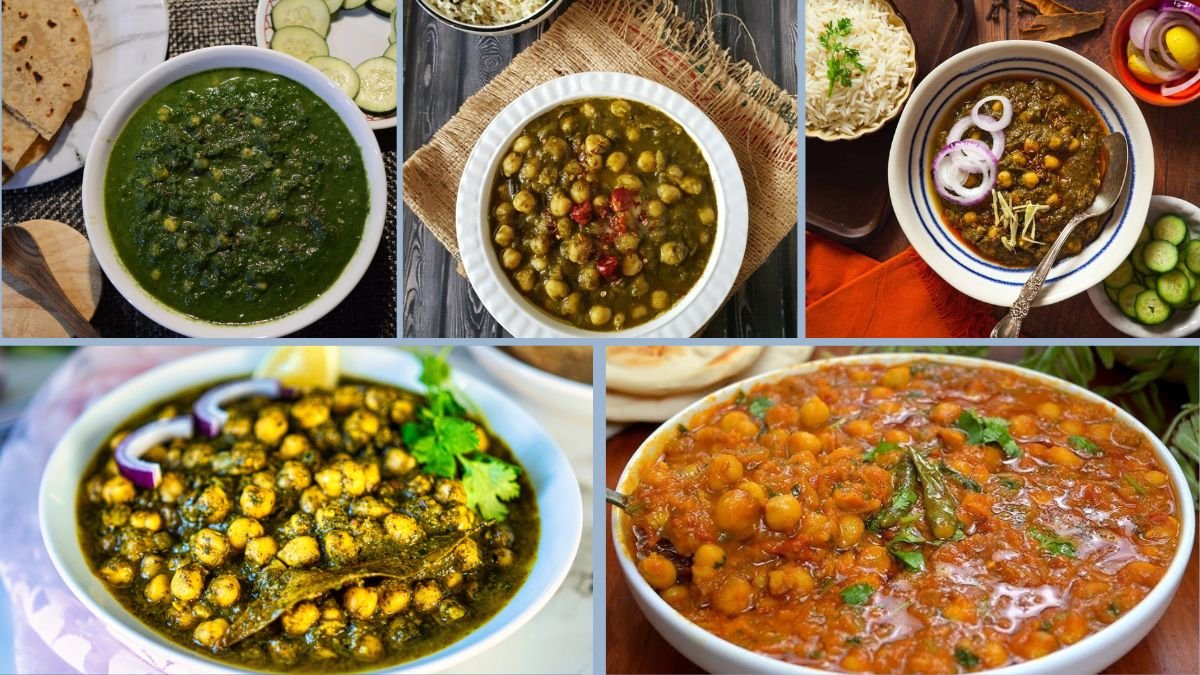“Palak Chole” (spinach with chickpeas) is a nutritious and satisfying variation of chole (chickpea curry). Traditional recipes sometimes use cream or full‑fat dairy to achieve richness and smooth texture. However, for health‑conscious diets, diets avoiding heavy dairy, or simply for a lighter version, it’s desirable to prepare Palak Chole without cream.
This article presents a 7‑step method to make Palak Chole that retains full flavor, good texture, and nutritional value—yet uses no cream or animal products. The approach is ideal for vegetarian and vegan diets, and it can serve as a model in culinary, nutrition, or food science research.
Why Omit Cream? And How to Retain Creaminess
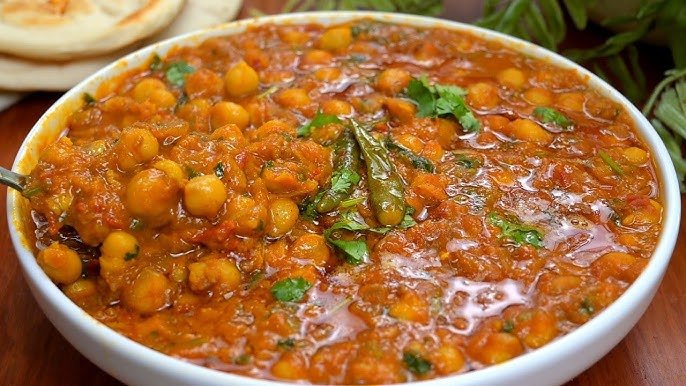
Removing cream eliminates saturated fat and reduces calorie load. But one must compensate so the gravy is not thin or bland. Key strategies:
- Use spinach (palak) & chickpeas as natural thickening agents (fiber, starch).
- Cashew paste, almond paste, or ground nuts can lend creaminess without dairy.
- Onion‑tomato gravy base cooked until oil separates builds a strong backbone.
- Pureeing part of the spinach + chickpeas helps emulsify the gravy.
With these tricks, you can get a creamy, rich Palak Chole without cream.
Step 1: Ingredient Selection & Pre‑Preparation
Essential Ingredients (serves ~4)
| Component | Ingredient | Quantity / Notes |
|---|---|---|
| Legume Base | Dried chickpeas (kabuli chana) | 1 cup (soaked overnight) |
| Green Leaf | Fresh spinach (palak) | 2 large bunches (≈ 200–250 g) |
| Aromatics & Base | Onion (chopped) | 1 medium |
| Tomato (ripe, chopped) | 2 medium | |
| Ginger‑garlic paste | 1 tbsp | |
| Green chilies (slit) | 1–2, or to taste | |
| Nuts for creaminess | Cashews or almonds (soaked) | 8–10 cashews or 8–10 almonds |
| Spices | Cumin seeds | ½ tsp |
| Turmeric powder | ¼ tsp | |
| Coriander powder | 1 tsp | |
| Red chili powder | ½ tsp (adjust) | |
| Garam masala | ½ tsp | |
| Salt | To taste | |
| Water / vegetable stock | As needed | |
| Garnish & finishing | Kasuri methi (dried fenugreek leaves) | 1 tsp |
| Fresh coriander leaves | Few sprigs |
Pre‑Preparation Tasks
- Soak chickpeas overnight (8–10 hours).
- Drain and rinse chickpeas before cooking.
- Wash spinach thoroughly, discard stems if very thick; chop roughly.
- Soak cashews/almonds in warm water for ~15 minutes, then drain.
- Chop onion, tomato, green chilies and prep ginger‑garlic paste.
With all ingredients ready, you can proceed swiftly through the cooking steps.
Step 2: Cook Chickpeas Until Tender
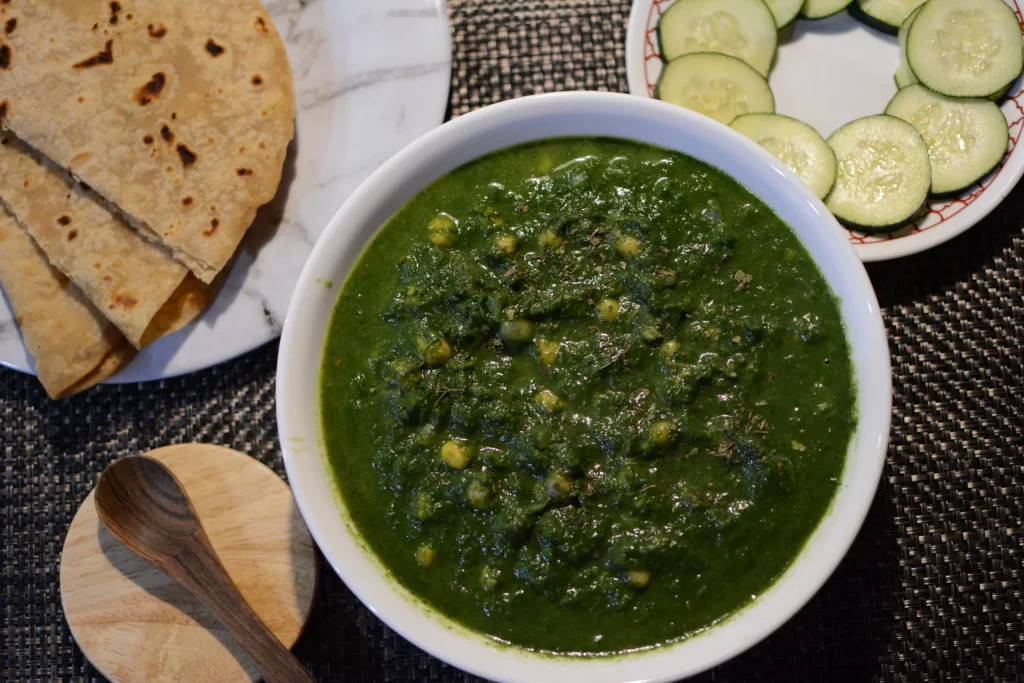
Chickpeas must be fully cooked but not disintegrated.
- Place soaked chickpeas in a pressure cooker or large pan.
- Add sufficient water (3–4 cups) and a pinch of salt; pressure cook for 3–4 whistles or cook in an open pan for ~45–60 minutes until soft.
- When done, reserve some cooking liquid and drain the chickpeas.
- Optionally, lightly mash ~¼ of the chickpeas (or press some against side) to help thicken the gravy.
Having tender, partially mashed chickpeas will contribute to body in the final gravy.
Step 3: Blanch & Puree Spinach (Palak)
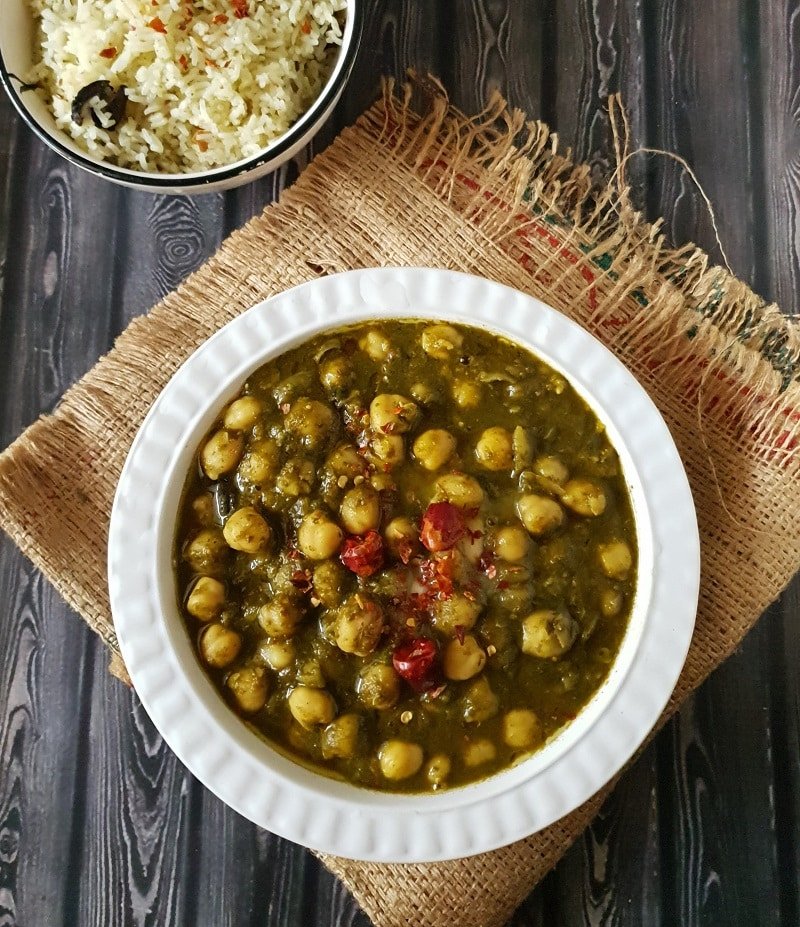
To get vibrant green color and smooth texture:
- Bring a pot of water to boil and add a pinch of salt.
- Drop the chopped spinach into the boiling water; blanch for 1 minute until wilted.
- Immediately transfer spinach to ice or cold water to halt cooking (preserve color).
- Drain thoroughly and squeeze out excess water.
- Blend the spinach into a fine puree, adding minimal water (just enough to make a smooth paste).
This spinach paste will be key in forming the base of your gravy without needing cream.
Step 4: Prepare the Onion–Tomato Base
A robust base ensures depth of flavor.
- In a heavy‑bottomed pan or kadai, heat 1 teaspoon oil or if you prefer no oil, use a “water sauté” method: add 1–2 tablespoons of water, then the spices to bloom.
- Add cumin seeds; let them crackle (or sizzle in the water).
- Add chopped onions and slit green chilies; sauté until onions turn translucent (or in water, stir frequently).
- Add ginger‑garlic paste, sauté until raw aroma disappears.
- Add chopped tomatoes, cook until soft and oil (if using oil) separates.
- Stir in turmeric, coriander powder, red chili powder; cook for 1–2 minutes.
This base is the spine onto which spinach and chickpeas will integrate.
Step 5: Integrate Spinach Puree, Chickpeas & Nut Creaminess
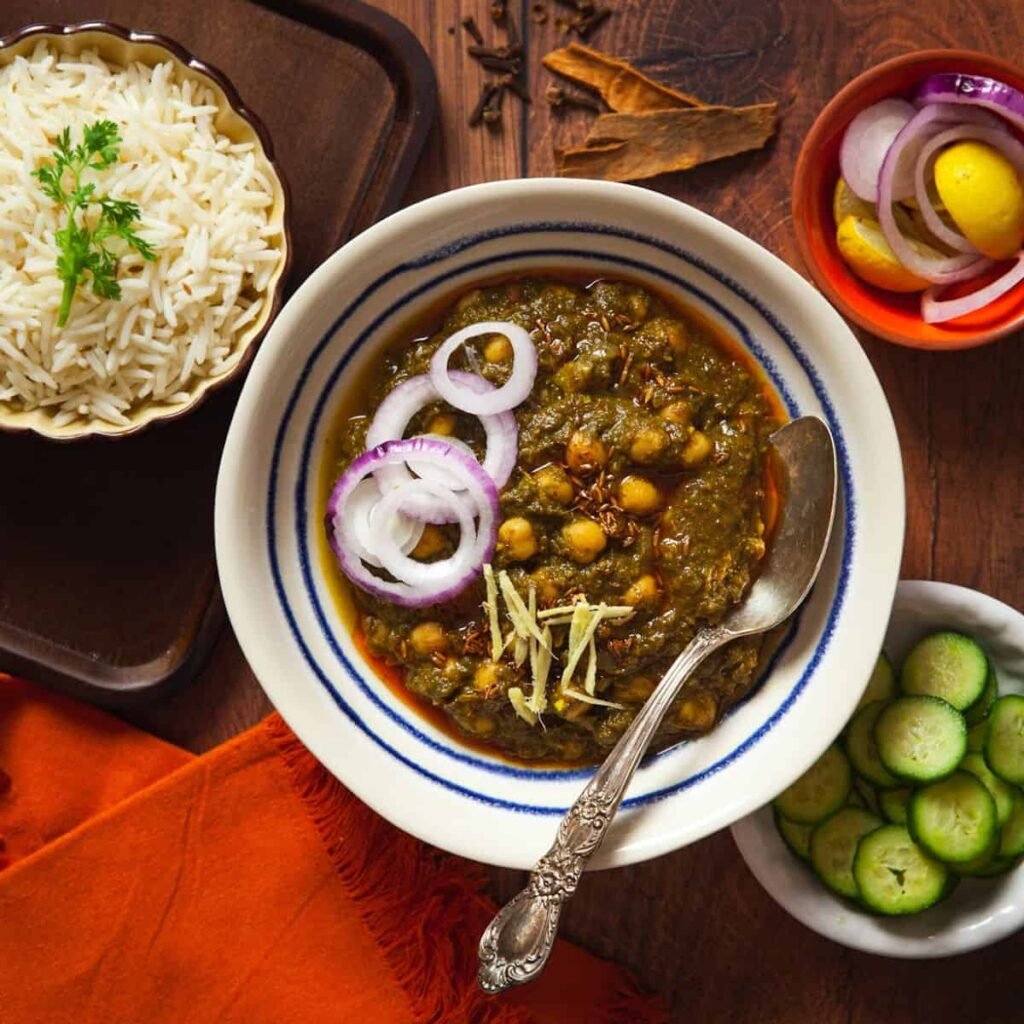
Now you create the final curry.
- Add the spinach puree to the onion‑tomato base; stir well.
- Next, add cooked chickpeas, including some reserved cooking liquid to reach desired consistency.
- Stir gently and bring to a gentle simmer (medium‑low).
- Meanwhile, blend soaked cashews/almonds into a smooth paste (with minimal water).
- Add that nut paste into the simmering curry, stirring to combine. This acts as the “cream substitute.”
- Let the mixture simmer for ~5–7 minutes, stirring occasionally, so flavors meld and the gravy thickens.
- Towards the end, add garam masala and kasuri methi, crushing kasuri methi between palms before sprinkling.
- Adjust salt, spice levels, and consistency (add water or reserved chickpea liquid if too thick).
At this point, your Palak Chole should exhibit a smooth, luscious, green curry consistency without any dairy cream.
Step 6: Final Resting & Garnishing
Let the dish settle, then finish with fresh touches.
- Turn off heat and cover the pan. Allow the curry to rest 5 minutes — this rest helps even out temperature and thicken slightly.
- Garnish with fresh coriander leaves just before serving.
- Optionally, drizzle a tiny amount of nut milk (from cashews/almonds) for visual appeal, but keep minimal to avoid mimicking cream.
- Serve hot with roti, naan, paratha, jeera rice, or steamed basmati rice.
Step 7: Accompaniments, Storage, Nutritional Notes & Troubleshooting
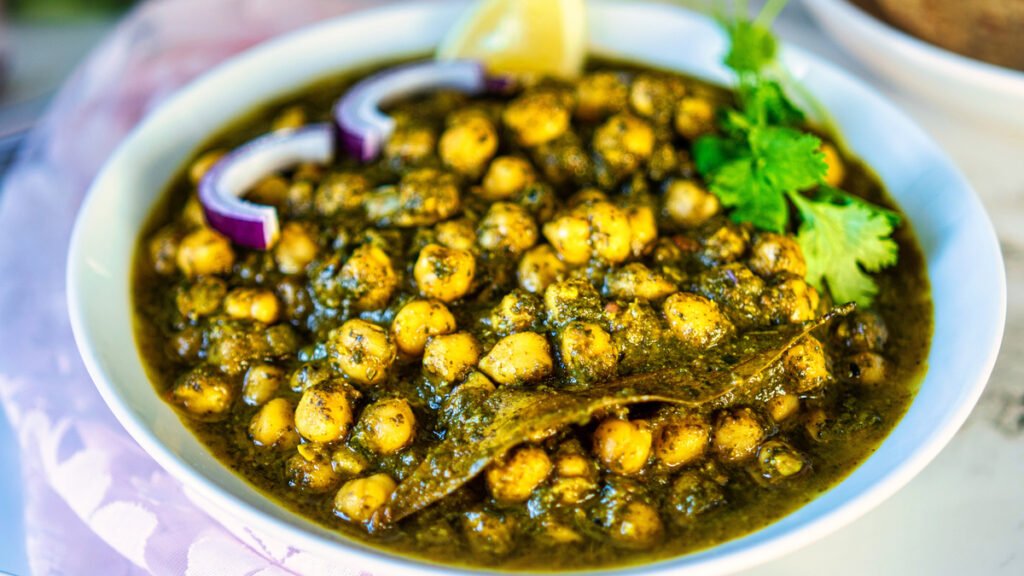
Serving Suggestions
- Serve with whole wheat roti or chapati for a balanced meal.
- Pair with brown rice or jeera rice for a complete vegetarian plate.
- A side of cucumber-onion salad or raita (yogurt, if your diet permits) works well.
Storage & Reheating
- Refrigerate leftover Palak Chole in airtight containers for up to 2 days.
- Reheat gently on stovetop, adding a splash of water if it thickens excessively.
- Avoid high heat reheating, which may cause separation of the nut paste.
Nutritional Highlights (Approx per serving)
- High in fiber, plant protein, iron, vitamin A & C, and antioxidants.
- Lower in saturated fat compared to cream‑based variants.
- Nut paste provides healthy fats and minerals, without excess dairy.
Common Issues & Troubleshooting
| Problem | Likely Cause | Remedy |
|---|---|---|
| Gravy too thin | Excess water or not enough thickening | Reduce liquid, mash more chickpeas, use more nut paste |
| Gravy too thick or pasty | Excess nut paste or little water | Add reserved chickpea liquid or water gradually |
| Spinach color dull or brownish | Overcooking or oxidation | Blanch carefully, shock in cold water |
| Bitter or raw nut taste | Nut paste not cooked enough | Let simmer longer after adding nut paste |
| Chickpeas hard or undercooked | Insufficient cooking time | Pre-cook chickpeas until fully tender |
Conclusion
This 7‑step method for Palak Chole without cream demonstrates how traditional, creamy Indian curries can be reimagined in a healthier, vegetarian manner. By using spinach and chickpeas as the core, and substituting cream with nut paste, you preserve richness, texture, and flavor while reducing saturated fat and ensuring full vegetarian integrity.
This version is ideal not only for home cooking but also as a case study in nutrition education, culinary innovation, or healthy recipe development. You can extend it via sensory evaluation, nutrient profiling, or even variant trials (e.g. using almond vs cashew, addition of tofu, variations of spices).
If you like, I can help you convert this into a thesis chapter, include tables, sensory evaluation plan, or even a shorter abstract. Do you want me to do that next?
